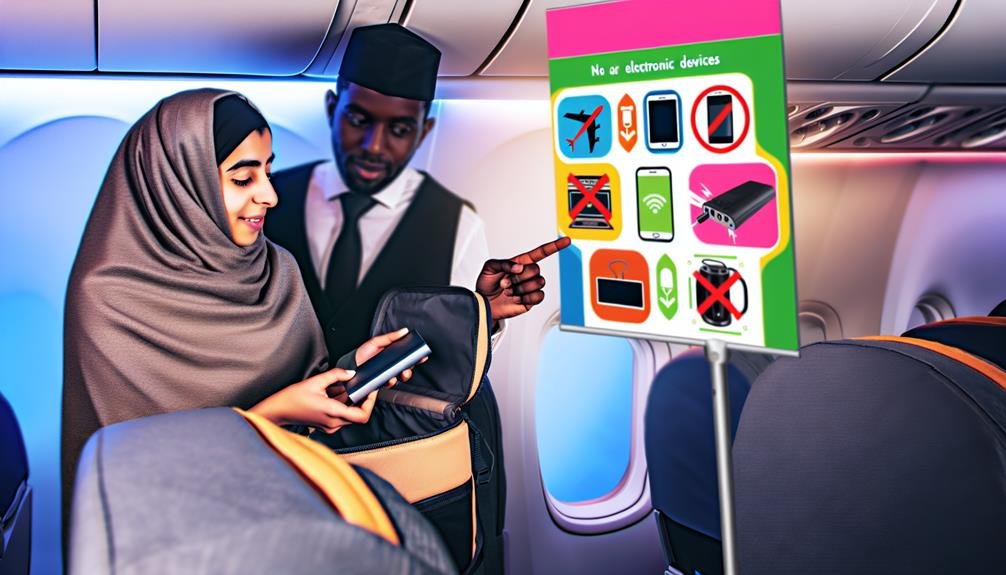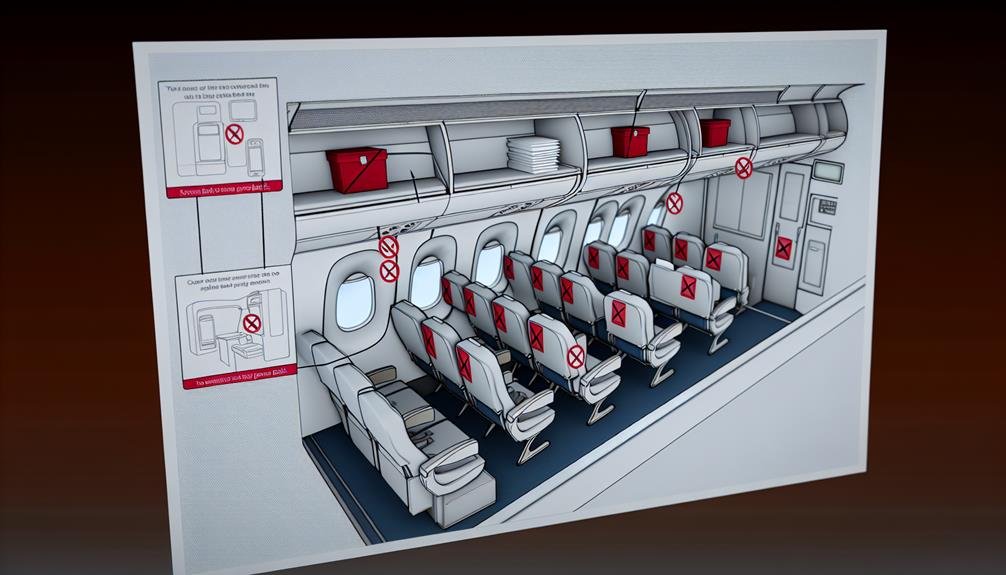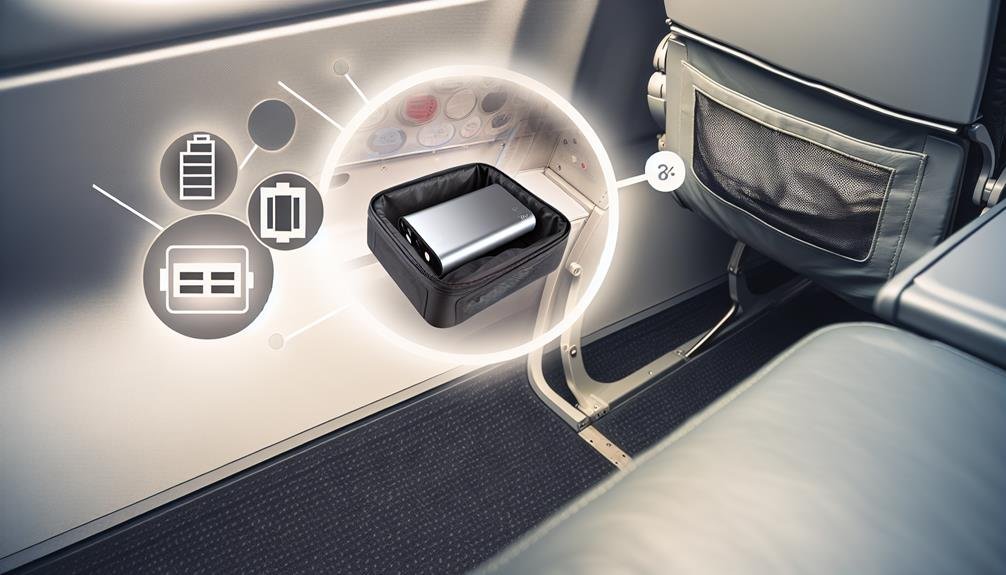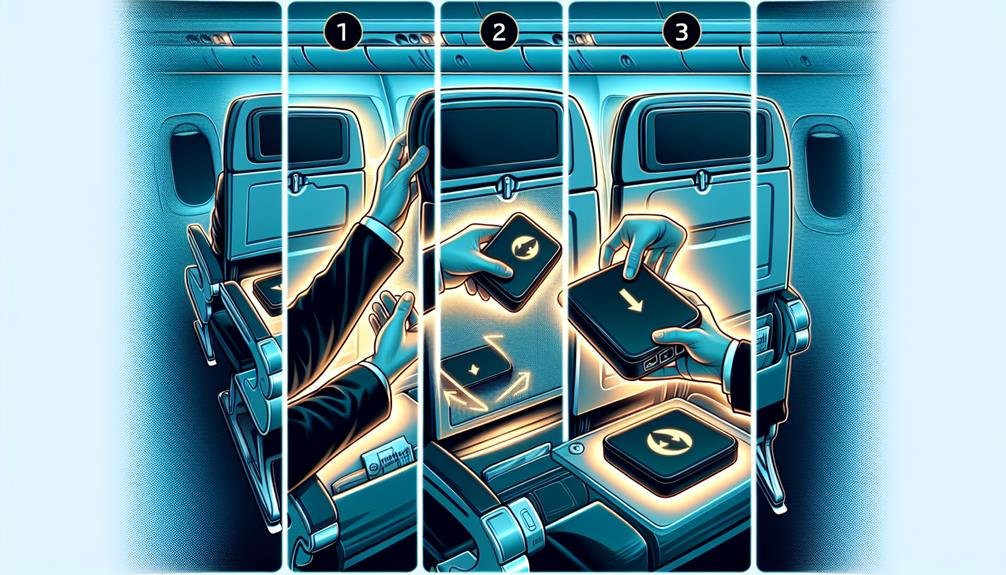Always keep your power bank in your carry-on luggage during a flight. Airlines prohibit placing power banks in checked baggage due to safety risks. Confirm the power bank meets the airline's watt-hour rating limits, typically up to 100 watt-hours. During security screenings, power banks require a separate inspection. For accessibility and safety, store your power bank under the seat. Avoid using it during the flight unless permitted by the airline. Following these guidelines guarantees compliance with airline regulations and prevents potential hazards. For further details on safety precautions and packing tips, let's explore additional information.
Airline Regulations

When traveling by air, it's crucial to understand the specific airline regulations regarding the placement and usage of power banks. Airlines have stringent rules to safeguard passenger safety, especially concerning lithium-ion batteries found in power banks. You must comply with these regulations to prevent any disruptions during your journey.
Firstly, power banks should never be placed in checked luggage due to the fire risk they pose. Instead, they must be carried in your hand luggage. Airlines often restrict power banks based on their watt-hour (Wh) rating. Typically, you're allowed to bring power banks up to 100Wh without special permissions. For power banks between 100Wh and 160Wh, you may need to obtain airline approval.
Security screenings also play a vital role. During these checks, you should be prepared to remove your power bank from your carry-on for separate inspection, much like laptops and other electronic devices. This guarantees that your power bank complies with safety standards and is easily accessible if needed.
Regarding charging options, it's advisable not to use your power bank during the flight unless the airline explicitly permits it. Some airlines offer in-seat power outlets, which are a safer alternative for charging your devices. Always follow crew instructions to ensure a secure and compliant travel experience.
Carry-On Luggage
When placing your power bank in your carry-on luggage, adhere to airline regulations prohibiting these devices in checked baggage. This placement enhances safety by reducing fire risks and guarantees accessibility should you need to recharge your devices during the flight. Always check specific airline policies to stay compliant and prepared.
Airline Regulations
Airlines typically require that power banks be placed in carry-on luggage due to the potential fire hazard they pose in checked baggage. This regulation guarantees that any thermal runaway or malfunctions can be managed promptly. When passing through airport security, you'll need to declare your portable chargers. Security personnel may ask you to remove them from your bag for separate screening. This helps confirm that the power banks comply with airline safety standards.
While traveling, portable chargers have become essential travel companions. They allow you to keep your devices powered without relying solely on airport charging stations. However, you should be aware that different airlines have specific rules on the capacity of power banks allowed on board. Generally, power banks with a capacity under 100Wh are permitted without prior approval, while those between 100Wh and 160Wh may require airline consent. Power banks exceeding 160Wh are typically prohibited.
It's essential to familiarize yourself with your airline's specific regulations to avoid any inconveniences at the airport. Always check the airline's website or contact customer service for precise guidelines. Adhering to these rules guarantees a safer travel experience for everyone on board.
Safety Considerations
Properly positioning your power bank in carry-on luggage is vital for maintaining in-flight safety standards. When storing your power bank, it's important to follow airline regulations and cabin crew instructions. Power banks should always be placed in your carry-on luggage and never in checked baggage. This ensures that any potential issues can be managed promptly.
For maximum safety, use in-seat storage or under-seat placement for your carry-on containing the power bank. These locations allow easy access for both you and the cabin crew during the flight. Ensuring that your power bank is readily accessible is crucial in case of an emergency. Familiarize yourself with the emergency procedures outlined by the cabin crew, as they will provide specific guidance on how to handle any issues with electronic devices.
Avoid placing power banks in overhead compartments where they might be less accessible in an emergency. Always monitor your power bank for any signs of damage or overheating during the flight. By following these precautions, you contribute to a safer flying environment for everyone on board. Remember, safety starts with proper positioning and adherence to airline guidelines.
Accessibility Benefits
Carrying your power bank in your carry-on baggage guarantees you have immediate access to it throughout the flight. This secures you can charge essential devices like your smartphone, tablet, or laptop without delay. You'll find this particularly useful if your seat lacks a built-in charging station. Having your power bank within reach minimizes disruptions and keeps you connected, productive, and entertained during the journey.
For maximum accessibility, place the power bank in a pocket organizer within your carry-on. This method prevents it from getting lost among other items and allows for quick retrieval when needed. Ensure the pocket organizer is designed to securely hold electronic devices, reducing the risk of damage or accidental activation.
Furthermore, keeping your power bank in your carry-on aligns with airline regulations, which often prohibit such devices in checked baggage due to safety concerns. This precaution enhances your overall travel safety by minimizing risks associated with lithium-ion batteries.
Prohibited Locations

You must never place power banks in checked baggage due to fire hazards. They're also prohibited in the cargo hold for the same safety reasons. Additionally, storing power banks in the overhead bins is strongly discouraged to prevent potential in-flight incidents.
Checked Baggage Restrictions
Airlines typically prohibit the placement of power banks in checked baggage due to safety concerns related to lithium-ion batteries. The primary issue lies in the potential for these batteries to overheat, short-circuit, or even catch fire, posing significant risks during flight. Airport security measures are stringent regarding lithium batteries, and compliance is essential to guarantee the safety of all passengers and crew.
When packing for a flight, you must place power banks in your carry-on luggage. This guarantees that if any issues arise, they can be addressed promptly by the crew. Device charging and the use of electronic devices are commonplace during flights, and having your power bank in your carry-on allows you to keep your electronic devices functional and safe.
It's vital to understand that different airlines may have specific regulations about the watt-hour rating of power banks allowed on board. Always check with your airline for precise guidelines. By adhering to these rules, you contribute to a safer flying environment for everyone. Remember, safety protocols are in place to mitigate risks associated with lithium-ion batteries and to safeguard all passengers during flight.
Cargo Hold Limitations
Due to strict safety regulations, power banks are strictly prohibited from being placed in the cargo hold during flights. This restriction is driven by the inherent cargo hold dangers associated with lithium-ion batteries, which have a well-documented risk of overheating and potentially causing fires. As a result, airlines have established clear rules to guarantee battery safety.
When considering storage options for your power bank, you must follow airline rules that explicitly forbid placing such devices in checked baggage. The cargo hold is not equipped with fire suppression systems that can effectively handle lithium battery fires. This limitation underscores the critical importance of adhering to these regulations.
It's crucial to understand that the primary concern is the potential for thermal runaway, a situation where a battery overheats uncontrollably. In the confined space of a cargo hold, this can lead to catastrophic outcomes. Airline rules are designed to minimize such risks and safeguard all passengers onboard.
Therefore, always remember to keep your power bank with your carry-on items. By doing so, you guarantee compliance with airline regulations and contribute to overall flight safety. Prioritize battery safety and follow the mandated storage options to avoid any complications during your journey.
Overhead Bin Concerns
While it's necessary to keep your power bank in the cabin, not all locations within the cabin are suitable for storage. Specifically, the overhead bin is a restricted location for power banks. Storing your power bank in the overhead bin poses safety risks due to temperature fluctuations and limited accessibility in case of an emergency.
For best safety, place your power bank under the seat in front of you or within a personal item such as a backpack or handbag. Keeping the power bank under the seat ensures it remains within reach, allowing you to quickly address any issues like overheating or malfunction. This location also provides a stable environment, reducing the risk of damage from sudden movements or turbulence.
When stored as part of a personal item, it's important to ensure the power bank is easily accessible. Avoid burying it under other belongings, which could delay your response time in an emergency. The cabin crew and aviation safety guidelines emphasize the importance of immediate access to potential fire hazards, making under-seat storage or placing it in a personal item the most secure options. By following these guidelines, you'll enhance in-flight safety and comply with airline regulations.
Checking Airline Policies
Before your flight, check the specific regulations your airline has regarding power bank placement and usage. Each airline may have distinct guidelines for carrying and using power banks, and it's vital to be informed to guarantee compliance and safety. Start by reviewing the airline guidelines on their official website or contacting customer service directly. Pay particular attention to any security procedures that pertain to electronic devices, as these can vary significantly between different carriers.
For in-flight charging, be aware that some airlines allow passengers to use power banks to charge their devices during the flight, while others may have restrictions. Make sure that your power bank complies with the airline's regulations, which may include restrictions on the capacity and type of battery. Always follow the crew's instructions regarding electronic devices to avoid any potential safety hazards.
Power Bank Capacity Limits

Airline regulations typically limit power bank capacity to a maximum of 100 watt-hours (Wh) without prior approval from the carrier. Exceeding this limit can result in your power bank being confiscated or denied boarding. To ensure compliance and safety, it's essential to understand the charging limitations and battery life of your portable devices.
To help you stay within the guidelines, here's what you need to keep in mind:
- Check the power bank's watt-hour (Wh) rating: Most airlines allow power banks up to 100Wh. If your power bank is between 100Wh and 160Wh, you may need special permission.
- Understand voltage requirements: Verify that your power bank meets the voltage requirements specified by the airline. Common voltage ratings are 3.7V and 5V.
- Inspect your power bank's labeling: Proper labeling helps avoid any confusion during security checks. Look for the Wh rating, voltage, and capacity details.
- Know the number of power banks allowed: Some airlines limit the number of power banks you can carry. Typically, it's two per passenger.
Packing Tips
When packing power banks for your flight, make sure they're easily accessible and stored in your carry-on luggage to adhere to safety regulations. Here are some specific packing tips to guarantee a smooth journey:
- Organize Your Carry-On: Designate a separate compartment for your portable chargers. This ensures they're easy to locate when passing through security checks.
- Use Protective Cases: To prevent any damage, place each power bank in a protective case. This is especially essential for high-capacity models.
- Check Airport Policies: Different airports may have specific guidelines. Familiarize yourself with these to avoid any hassles at charging stations or airport lounges.
Here's a quick reference table to help you pack efficiently:
| Item | Placement |
|---|---|
| Portable Chargers | Separate compartment in carry-on |
| Charging Cables | Ziplock bag in carry-on |
| Protective Cases | Around each power bank |
| Travel Essentials | Organized in carry-on |
| Spare Batteries | Separate pouch in carry-on |
- Keep Essentials Handy: Make sure other travel essentials, like charging cables and adapters, are also in your carry-on. This makes it easier to use charging stations in airport lounges.
- Label Your Gear: Clearly label your portable chargers and accessories. This helps in quick identification and minimizes the risk of loss.
Safety Precautions

To secure safe travel with power banks, always adhere to airline regulations and manufacturer guidelines. Understanding these rules assures your journey is secure and stress-free. First, familiarize yourself with the allowable watt-hour (Wh) limits for power banks, as most airlines permit devices up to 100 Wh without prior approval. Power banks exceeding this limit often require specific airline consent.
When passing through security checkpoints, make sure your power bank is easily accessible. Place it in your carry-on luggage, as storing it in checked baggage is prohibited. This facilitates quick inspection and minimizes delays.
Observe proper charging etiquette to extend the battery lifespan of your power bank. Avoid overcharging and always use the provided cables and chargers. Additionally, refrain from using the power bank while it's charging to prevent overheating.
Follow these four essential safety tips:
- Check Airline Policies: Confirm the specific regulations for power banks on your airline's website.
- Use Manufacturer's Guidelines: Stick to the usage and charging recommendations provided by the manufacturer.
- Keep Power Banks in Carry-On: Never pack power banks in checked luggage.
- Perform Regular Inspections: Routinely check your power bank for any damage or swelling.
Frequently Asked Questions
Can I Use My Power Bank to Charge Devices During the Flight?
Imagine a ship sailing through turbulent skies. Yes, you can use your power bank, but observe charging etiquette and prioritize battery safety. Use airline-approved power banks and follow crew instructions to guarantee everyone's safety.
What Should I Do if My Power Bank Gets Damaged During the Flight?
If your power bank gets damaged during the flight, immediately inform the flight crew. Adhere to flight regulations and prioritize power bank safety. Damaged power banks can pose risks, so timely reporting is vital for everyone's safety.
Are There Specific Brands of Power Banks Recommended for Air Travel?
Think of Icarus and heed airline restrictions. For safe air travel, choose power banks from reputable brands like Anker or RavPower. Always verify they meet power bank regulations, specifically under 100Wh, to avoid issues.
How Can I Check the Charge Level of My Power Bank Before Boarding?
To check your power bank's charge level before boarding, confirm it's compatible with your device's charging options. Most power banks have LED indicators or digital displays. Refer to the user manual for precise instructions on checking battery status.
Are There Any Airlines That Provide Power Outlets at Every Seat?
Yes, many modern airlines provide power outlets at every seat for in-flight entertainment and charging stations. Check your airline's website for specifics to guarantee you can safely and conveniently charge your devices during the flight.



